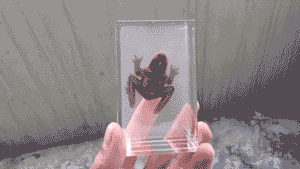When is printing in three dimensions ‘3D printing?’ Is a 3D print pen 3D printing? Probably not. Is General Electrics ‘3D painting’ a kind of additive manufacturing? I guess so. There is now, probably, a popular culture ‘3D printing’ that includes ideas like the Mink MakeUp Printer. The lines between what is, and is not, 3D printing have become slightly blurred. This article is about something that probably isn’t 3D printing. But, as it’s printing in a way that creates a form in three dimensions, and so darn cool, how could we resist taking a closer look?
At first glance of the pending Kickstarter campaign for Looking Glass Volumetric Printing a few words came to mind: hologram, taxidermy, cryogenics, formaldehyde. Also Ghost Pepper illusions as can be found in the really very good movie The Illusionist. And of course ‘Help me Obi-Wan Kenobi you’re my only hope.’ What comes to your mind?

Stratafied layers built up to form a three dimensional manifestation of an object. You can see the link to 3D printing. I’d say that this is not ‘officially 3D printing,’ but it’s a fascinating way of creating some bona fide interesting objects.
The Looking Glass is made from hundreds of sheets of lucite, each printed with a tiny slice of the 3D model. When the printed slices are stacked on top of each other to produce the complete copy of the image of the subject form, then put into a vacuum chamber and injected with a refractive index-matching fluid, the result is a volumetrically printed ‘Looking Glass.’ The Looking Glass team says that the process is ten to twenty times faster than conventional desktop 3D printing and has the added bonus of being able to output in millions of colours.
Most applications of 3D printing are – it has to be said – not directly comparable, as 3D printing focuses upon a form that is extant, not held within a suspending medium as per volumetric printing in glass. But there are comparable applications such as the Japanese company Fasotec which innovatively 3D prints ultrasound scans and then frames the print in a cuboid glass medium for display purposes as exampled below.
The Looking Glass crowdfunding campaign starts on Kickstarter today, with more insights into the interesting methods behind the production of the lucite printed ornaments and of course a chance to own one yourself. You can also check out the company website here.
Looking Glass: March 2014 from Looking Glass on Vimeo.


